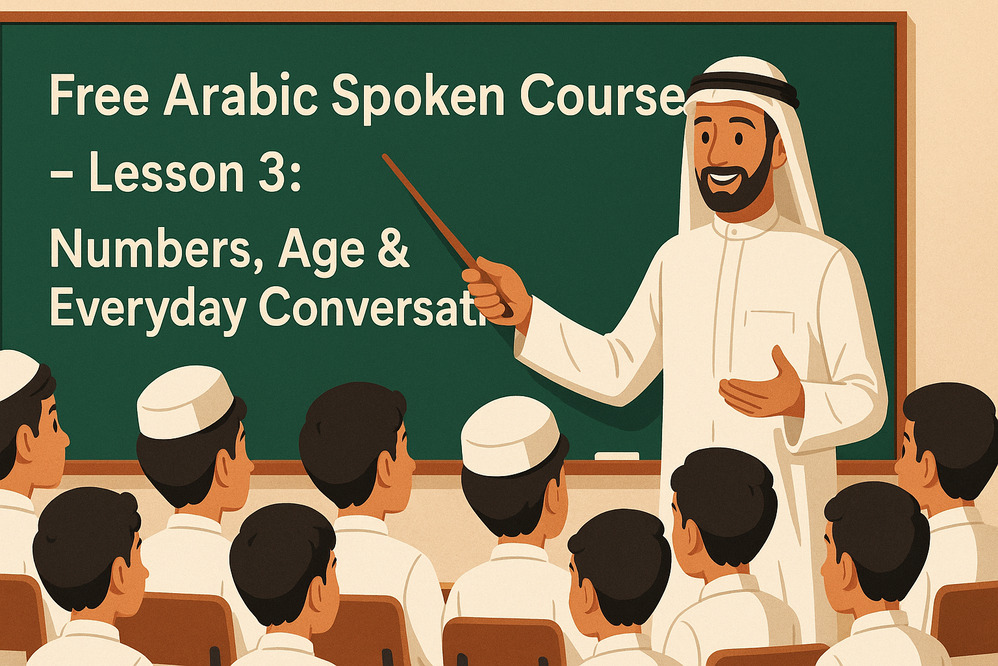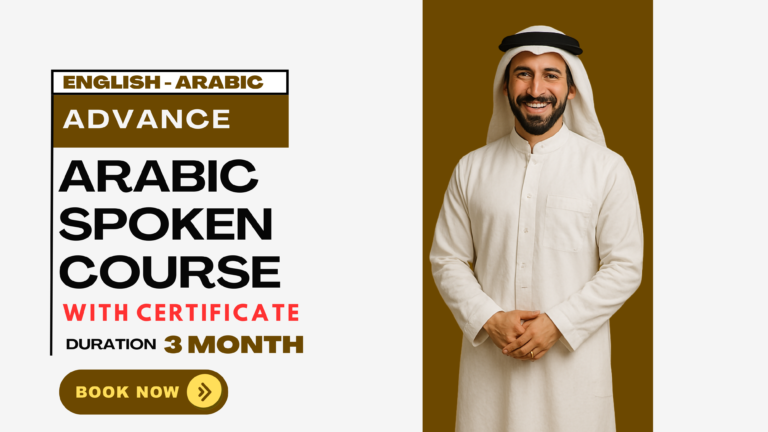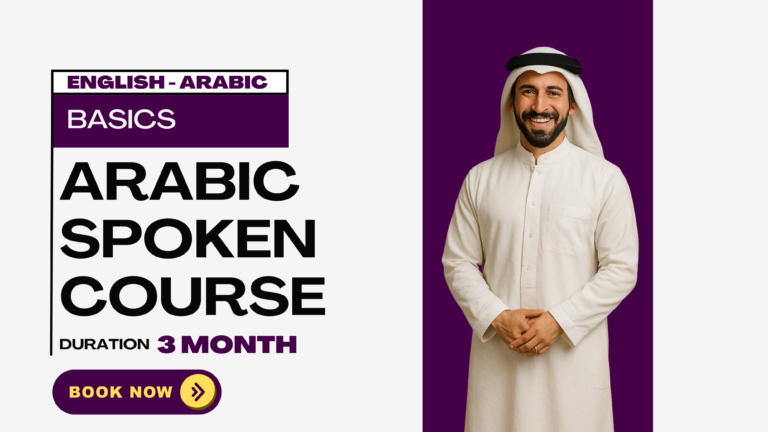Part of the free Arabic Spoken Course Series
Have you ever been in a Gulf country—or chatting online with a Gulf friend—and suddenly wished you knew how to ask someone’s age or say your own? If you only know how to count to “wahid” (1), don’t worry. Today’s lesson is your beginner-friendly guide to numbers in Gulf Arabic and how to talk about age naturally and politely.
Whether you’re heading to Saudi Arabia, Kuwait, the UAE, or just want to understand Gulf speakers better, this lesson will help you sound more authentic from day one.
🧠 Why Numbers Matter in Real-Life Arabic
Numbers are everywhere: from telling your age, buying groceries, giving your phone number, to asking the time. But numbers in Gulf Arabic (اللهجة الخليجية) sound a little different from Modern Standard Arabic (MSA)—especially in casual conversation.
That’s why we’re focusing on:
✅ Numbers 1–20 (plus tens)
✅ How to ask and answer “How old are you?”
✅ Useful cultural notes
✅ A real-life dialogue to practice with
📚 Vocabulary: Numbers in Gulf Arabic (1–20)
Here’s your go-to chart for numbers 1 to 20. We’ve included the Arabic script, Romanized pronunciation, and the English meaning.
| English | Arabic | Roman Arabic |
|---|---|---|
| 1 | واحد | wāḥid |
| 2 | اثنين | ithnayn / ithnēn |
| 3 | ثلاثة | thalātha |
| 4 | أربعة | arba‘a |
| 5 | خمسة | khamsa |
| 6 | ستة | sitta |
| 7 | سبعة | sab‘a |
| 8 | ثمانية | thamāniya |
| 9 | تسعة | tis‘a |
| 10 | عشرة | ‘ashara |
| 11 | أحد عشر | aḥad ‘ashar |
| 12 | اثنا عشر | ithnā ‘ashar |
| 13 | ثلاثة عشر | thalātha ‘ashar |
| 14 | أربعة عشر | arba‘a ‘ashar |
| 15 | خمسة عشر | khamsa ‘ashar |
| 16 | ستة عشر | sitta ‘ashar |
| 17 | سبعة عشر | sab‘a ‘ashar |
| 18 | ثمانية عشر | thamāniya ‘ashar |
| 19 | تسعة عشر | tis‘a ‘ashar |
| 20 | عشرين | ‘ishrīn |
👉 Gulf Accent Tip:
In conversation, you’ll often hear these numbers pronounced softly. For example:
- “ithnayn” sounds like “ithnēn”
- “arba‘a” might become just “arba‘”
🗣️ How to Ask “How Old Are You?” in Gulf Arabic
The most common phrase is:
- Arabic: كم عمرك؟
- Roman Arabic: kam ‘umrik?
- English: How old are you?
🧍♂️ Example Answer:
Arabic: أنا عمري خمسة وعشرين سنة.
Roman Arabic: Ana ʿumrī khamsa w ʿishrīn sana.
English: I am 25 years old.
🧠 Word Breakdown:
| Arabic | Roman Arabic | Meaning |
|---|---|---|
| أنا | ana | I |
| عمري | ʿumrī | my age |
| خمسة | khamsa | five |
| وعشرين | w ʿishrīn | and twenty |
| سنة | sana | year |
👉 Grammar Tip:
Use “w” to connect numbers (like 5 and 20 → khamsa w ʿishrīn). Always say the number before “sana” (year).
🧑🏫 Cultural Tip: Be Polite with Age Questions
In Gulf culture, asking someone’s age is usually fine—especially with friends or younger people. But when talking to older people or in formal situations, it’s better to be polite or let them share their age first.
Try this softer version:
Arabic: ممكن أسأل، كم عمرك؟
Roman Arabic: Mumkin as’al, kam ‘umrik?
English: May I ask, how old are you?
🔢 Bonus: Counting by Tens
Here’s a quick chart to help you go beyond 20.
| English | Arabic | Roman Arabic |
|---|---|---|
| 30 | ثلاثين | thalāthīn |
| 40 | أربعين | arba‘īn |
| 50 | خمسين | khamsīn |
| 60 | ستين | sittīn |
| 70 | سبعين | sab‘īn |
| 80 | ثمانين | thamānīn |
| 90 | تسعين | tis‘īn |
| 100 | مئة | mi’a |
You can combine them easily:
- 35 = خمسة و ثلاثين → khamsa w thalāthīn
- 48 = ثمانية و أربعين → thamāniya w arba‘īn
🏦 Large Numbers in Gulf Arabic
| English | Arabic | Roman Arabic |
|---|---|---|
| 1,000 | ألف | alf |
| 10,000 | عشرة آلاف | ‘ashara alāf |
| 100,000 | مئة ألف | miya alf |
| 1,000,000 (1 million) | مليون | milyūn |
| 10,000,000 | عشرة ملايين | ‘ashara malāyīn |
| 100,000,000 | مئة مليون | miya milyūn |
| 10,00,000 (1 lakh) | مئة ألف | miya alf (used instead of “lakh”) |
| 1 crore (10 million) | عشرة ملايين | ‘ashara malāyīn |
❗ Gulf Arabic doesn’t use “lakh” or “crore” natively—those are used in South Asia. In Gulf Arabic, we use “thousand,” “million,” and “billion.”
✏️ Grammar Tips
- In Gulf Arabic, the number often precedes the noun (e.g., thalātha ikhwān = three brothers).
- Use w (and) to connect tens and units: khamsa w thalāthīn (35).
- When talking about currency, “riyāl” stays singular after 3+ (no plural form): khamsa riyāl, not riyālāt.
👩🏫 Arabic Spoken Course: Sample Dialogue + Word-by-Word (Conversations 1–10)
These cover a variety of real-life situations.
🗨️ Conversation 1 – At a Coffee Shop
📌 Dialogue
Arabic Script:
🧑💼: السلام عليكم، كم عمرك؟
👩🦰: وعليكم السلام، عمري تسعة عشر سنة. وأنت؟
🧑💼: أنا عمري اثنين وعشرين سنة.
Roman Arabic:
🧑💼: Assalāmu ʿalaykum, kam ʿumrik?
👩🦰: Wa ʿalaykum assalām, ʿumrī tisʿa ʿashar sana. W inta?
🧑💼: Ana ʿumrī ithnēn w ʿishrīn sana.
English:
🧑💼: Peace be upon you, how old are you?
👩🦰: And peace be upon you, I’m nineteen years old. And you?
🧑💼: I’m twenty-two years old.
🧩 Word-by-Word Table
| Arabic | Roman Arabic | English Meaning |
|---|---|---|
| السلام عليكم | Assalāmu ʿalaykum | Peace be upon you |
| كم | Kam | How much / How |
| عمرك؟ | ʿumrik? | Your age? |
| وعليكم السلام | Wa ʿalaykum assalām | And peace be upon you |
| عمري | ʿumrī | My age |
| تسعة عشر | Tisʿa ʿashar | Nineteen |
| سنة | Sana | Year |
| وأنت؟ | W inta? | And you? |
| أنا | Ana | I |
| اثنين وعشرين | Ithnēn w ʿishrīn | Twenty-two |
🗨️ Conversation 2 – At a Market Stall
📌 Dialogue
Arabic Script:
👨🦱: بكم هذا؟
👨🦳: بخمسة و ثلاثين ريال.
Roman Arabic:
👨🦱: Bikam hādhā?
👨🦳: B khamsa w thalāthīn riyāl.
English:
👨🦱: How much is this?
👨🦳: It’s thirty-five riyals.
🧩 Word-by-Word Table
| Arabic | Roman Arabic | English Meaning |
|---|---|---|
| بكم | Bikam | How much (price)? |
| هذا | Hādhā | This |
| بخمسة | B khamsa | For five |
| و ثلاثين | W thalāthīn | And thirty |
| ريال | Riyāl | Riyal (currency) |
🗨️ Conversation 3 – Talking About Salary
📌 Dialogue
Arabic Script:
👨💼: كم راتبك؟
👨🔧: راتبي ثمانية آلاف وخمسمية.
Roman Arabic:
👨💼: Kam rātbak?
👨🔧: Rātbī thamāniyat alāf w khamsmiyya.
English:
👨💼: What’s your salary?
👨🔧: My salary is eight thousand five hundred.
🧩 Word-by-Word Table
| Arabic | Roman Arabic | English Meaning |
|---|---|---|
| كم | Kam | How much / What |
| راتبك؟ | Rātbak? | Your salary? |
| راتبي | Rātbī | My salary |
| ثمانية آلاف | Thamāniyat alāf | Eight thousand |
| و خمسمية | W khamsmiyya | And five hundred |
🗨️ Conversation 4 – Booking a Hotel Room
📌 Dialogue
Arabic Script:
👩💼: كم سعر الغرفة لليلة؟
👨💼: ستمية وخمسين ريال.
Roman Arabic:
👩💼: Kam siʿr al-ghurfa lil-layla?
👨💼: Sittmiyya w khamsīn riyāl.
English:
👩💼: How much is the room per night?
👨💼: Six hundred fifty riyals.
🧩 Word-by-Word Table
| Arabic | Roman Arabic | English Meaning |
|---|---|---|
| كم | Kam | How much |
| سعر | Siʿr | Price |
| الغرفة | Al-ghurfa | The room |
| لليلة | Lil-layla | Per night |
| ستمية | Sittmiyya | Six hundred |
| وخمسين | W khamsīn | And fifty |
| ريال | Riyāl | Riyal (currency) |
🗨️ Conversation 5 – Talking About Family Members
📌 Dialogue
Arabic Script:
👧: كم أخ عندك؟
👩🦱: عندي أربعة أخوان.
Roman Arabic:
👧: Kam akh ʿindak?
👩🦱: ʿIndī arbaʿa ikhwan.
English:
👧: How many brothers do you have?
👩🦱: I have four brothers.
🧩 Word-by-Word Table
| Arabic | Roman Arabic | English Meaning |
|---|---|---|
| كم | Kam | How many |
| أخ | Akh | Brother |
| عندك؟ | ʿIndak? | Do you have? |
| عندي | ʿIndī | I have |
| أربعة | Arbaʿa | Four |
| أخوان | Ikhwan | Brothers (dual/plural) |
🗨️ Conversation 6 – Asking About Distance
📌 Dialogue
Arabic Script:
👨✈️: كم كيلو من هنا إلى الدمام؟
👳: حوالي مية وعشرة كيلومتر.
Roman Arabic:
👨✈️: Kam kīlo min hinā ilā ad-Dammām?
👳: Ḥawālī miya w ʿashara kīlōmētar.
English:
👨✈️: How many kilometers from here to Dammam?
👳: About one hundred ten kilometers.
🧩 Word-by-Word Table
| Arabic | Roman Arabic | English Meaning |
|---|---|---|
| كم | Kam | How many |
| كيلو | Kīlo | Kilo / Kilometer |
| من هنا | Min hinā | From here |
| إلى الدمام | Ilā ad-Dammām | To Dammam |
| حوالي | Ḥawālī | About / approximately |
| مية | Miya | One hundred |
| وعشرة | W ʿashara | And ten |
| كيلومتر | Kīlōmētar | Kilometer |
🗨️ Conversation 7 – Talking About Time
📌 Dialogue
Arabic Script:
🧒: كم الساعة؟
👨: الساعة تسعة ونص.
Roman Arabic:
🧒: Kam as-sāʿa?
👨: As-sāʿa tisʿa w niṣṣ.
English:
🧒: What time is it?
👨: It’s nine thirty.
🧩 Word-by-Word Table
| Arabic | Roman Arabic | English Meaning |
|---|---|---|
| كم | Kam | What / How much |
| الساعة | As-sāʿa | The hour / The time |
| تسعة | Tisʿa | Nine |
| و نص | W niṣṣ | And a half (thirty mins) |
🗨️ Conversation 8 – Shopping for Furniture
📌 Dialogue
Arabic Script:
👩🦰: كم سعر الطاولة؟
👨🔧: بألفين وخمسمية ريال.
Roman Arabic:
👩🦰: Kam siʿr aṭ-ṭāwla?
👨🔧: B alfayn w khamsmiyya riyāl.
English:
👩🦰: How much is the table?
👨🔧: Two thousand five hundred riyals.
🧩 Word-by-Word Table
| Arabic | Roman Arabic | English Meaning |
|---|---|---|
| كم | Kam | How much |
| سعر | Siʿr | Price |
| الطاولة | Aṭ-ṭāwla | The table |
| بألفين | B alfayn | For two thousand |
| و خمسمية | W khamsmiyya | And five hundred |
| ريال | Riyāl | Riyal (currency) |
🗨️ Conversation 9 – Discussing Followers on Social Media
📌 Dialogue
👦: كم عندك متابع؟
👧: عندي ثلاثمية وخمسين ألف.
Roman Arabic:
👦: Kam ʿindak mutābiʿ?
👧: ʿIndī thalāthmiyya w khamsīn ālf.
English:
👦: How many followers do you have?
👧: I have three hundred fifty thousand.
🧩 Word-by-Word Table
| Arabic | Roman Arabic | English Meaning |
|---|---|---|
| كم | Kam | How many |
| عندك | ʿIndak | Do you have? |
| متابع | Mutābiʿ | Follower |
| عندي | ʿIndī | I have |
| ثلاثمية | Thalāthmiyya | Three hundred |
| و خمسين | W khamsīn | And fifty |
| ألف | Ālf | Thousand |
🗨️ Conversation 10 – Talking About a Business Deal
📌 Dialogue
👨💼: الصفقة كانت بمليون وربع.
👨🔧: ما شاء الله، رقم كبير!
Roman Arabic:
👨💼: Aṣ-ṣafqa kānat b milyūn w rubʿ.
👨🔧: Mā shā’ Allāh, raqam kabīr!
English:
👨💼: The deal was for one million and a quarter.
👨🔧: Wow, that’s a big number!
🧩 Word-by-Word Table
| Arabic | Roman Arabic | English Meaning |
|---|---|---|
| الصفقة | Aṣ-ṣafqa | The deal |
| كانت | Kānat | Was |
| بمليون | B milyūn | For one million |
| وربع | W rubʿ | And a quarter |
| ما شاء الله | Mā shā’ Allāh | God has willed it (Wow) |
| رقم | Raqam | Number |
| كبير | Kabīr | Big / Large |
🧕 Cultural Tips: Numbers in Daily Gulf Life
- Politeness Matters: When asking someone’s age, add a polite phrase like ممكن أسأل؟ (mumkin as’al?)
- Business Conversations: Numbers are crucial in bargaining and budgeting. Be ready to say prices with confidence.
- Lucky Numbers: Gulf culture doesn’t focus much on numerology, but even/round numbers (e.g., 10, 100, 1000) are often preferred in negotiation.
- Use of “lakh” and “crore”: These are not used in Gulf Arabic. Replace with “hundred thousand” (miya alf) and “ten million” (‘ashara malāyīn).
✅ Key Takeaways
- Use kam ‘umrik? to ask someone’s age.
- Answer with ‘umrī + number + sana.
- Learn the Gulf Arabic accent for smoother conversation.
- Be polite when talking about age in formal settings.
🧪 Mini Quiz – Test Yourself!
Translate the following into Gulf Arabic:
- I am 37 years old.
- The bill is 94 riyals.
- I have 2 cars.
- My salary is 8,500 riyals.
- They bought the company for 3 million.
🔗 Related Posts from the Arabic Spoken Course Series
- Free Arabic Spoken Course- Lesson 1: Greetings & Introductions
- Free Arabic Spoken Course- Lesson 2: Introducing Yourself and Asking Names
- Arabic Conversation Phrases for Beginners
- Arabic Conversation for Job Interviews
Frequently Asked Questions – Numbers & Age in Gulf Arabic
📥 Call to Action
✅ Buy our Speak Arabic Like Arab E-Book
✅ Enroll in our Live Arabic Classes – Interactive Gulf Arabic taught online
✅ Follow our Free Arabic Spoken Course












